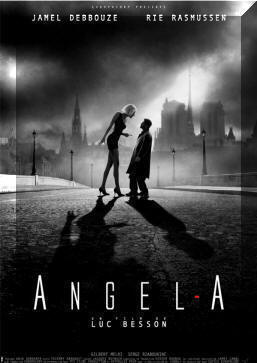|
 Do
you dream in colour or black and white? In his latest (- and
allegedly last) film, director Luc Besson shows us the colour of his
dreams. They are black and white and silvery, luminous and glowing. In
Besson’s dreams, angels take form in glorious, sylphlike six-foot
blondes with a propensity toward teeny, little miniskirts that barely
cover endless legs gliding across the ground in very high stiletto
heels. Do
you dream in colour or black and white? In his latest (- and
allegedly last) film, director Luc Besson shows us the colour of his
dreams. They are black and white and silvery, luminous and glowing. In
Besson’s dreams, angels take form in glorious, sylphlike six-foot
blondes with a propensity toward teeny, little miniskirts that barely
cover endless legs gliding across the ground in very high stiletto
heels.
Angel-A introduces us to Andre, a Parisian petty
criminal who can’t catch a break. Everything he touches turns to
merde. Running a variety of failed scams, Andre’s got a lot of
people unhappy with him. There’s no help or sympathy to be found, so
before he is killed by any number of gangsters out for his blood, Andre
decides to end it all by taking a flying leap into the river Seine. Even
this goes wrong for Andre as his great plan to off himself is thwarted
after he sees someone else one pillar down taking a flying leap off the
same bridge. Andre, overcome with an unfamiliar heroic urge, jumps in
after his partner in self-destruction, and out of the Seine Andre
delivers the person who actually will end his life as he knew it.
Lying on the riverbank is the nearly-drowned vision
of platinum hair, minidress, and legs legs legs called Angela. Once
conscious, Angela’s gratitude to Andre knows no bounds, she is
determined to help her soggy saviour with his various troubles and she
won’t take no for an answer. Andre kicks and screams but slowly and
surely this free-spirited 6-foot hurricane transforms Andre and his
entire reason for being. The question for the viewer is, who is Angela?
Is she just a really grateful supermodel, or is there more to her
assumed guardianship of Andre’s outer (- and inner) well-being?
Andre is portrayed by the popular French comedian
Jamel Debbouze. When speaking with anyone, the short, dark and hairy
Andre has a tendency to grab at them or push himself into their faces to
keep their attention, making the character like a persistent housefly.
He’s nervous, grouchy and high strung, kind of like a cranky Chihuahua.
His joylessness, helplessness and faith in nothing make Angela’s entry
into his life so much more marked. She is all things airy and hopeful
and bright. Her utter lightness is a perfect foil for Andre’s darkness,
both in his physicality and his soul. Danish actress Rie Rasmussen plays
Angela, and she is all long, outstretched limbs and a larger-than-life
presence that makes the wonder of her character utterly believable.
She’s a tall drink of water of a woman and instills Angela with complete
freedom and unselfconsciousness. Rasmussen’s utter comfort inside her
goddess-sized skin reminded me of another fabulous, free-spirited Amazon
by the name of Julie Newmar in her 1960’s prime; both ladies completely
self- possessed and glorying in their divine, over-the-top
physicalities, so much so that it becomes a core part of their
performance. There is a wonderful scene where Angela forces Andre to
really look at himself in a mirror; caging him within her long arms and
body like an extraterrestrial creature, her gorgeous head leaning on his
shoulder. That scene embodied the way Angela had wrapped herself around
Andre’s life, surrounding him with her warmth, her positivity and love.
He couldn’t turn away from seeing himself the way Angela sees him and it
is a cathartic moment for Andre and for the audience. The perfect match
between these utterly different looking actors created a chemistry which
is one of the most touching I’ve seen in a film for many ages.
The other costar of the film is the City of Lights
itself. If Angel-A is indeed Luc Besson’s swan song (- and I hope it
isn’t.), then he’s said a proper goodbye with gratitude to the city
that has served as his artistic inspiration. The breathtaking black and
white images of Paris in this film are clearly taken by someone very
much in love with it. The monuments of Paris, so universally well-known,
appear dreamlike and unreal when filmed in the sumptuous, rich lighting
of Thierry Arbogast’s photography. Ofttimes, there are hardly any other
people for miles in scenes featuring some of Paris’ most famous tourist
attractions, which meant the eye was not distracted by anything but the
sheer beauty of the photography, and also helped to make the scenes
between Andre and Angela, two strangers who come together in this most
beautiful and well traveled of cities, even more intimate. Even the
nightclub scenes filmed in the seedier backstreets have a texture to
them that let you know the majesty of the Paris by day, turns into a
very different animal by night. The overwhelming beauty of the
photography of Paris, and the production design of Angel-A are as
essential to the film as any of the actors.
This film is an entirely different change of pace
for Besson and marks a new grace and maturity from the man who gave us
the groundbreaking Nikita and Leon. While both those films and others
he’s directed were remarkable productions, Angel-A is a turning point
for Besson stylistically, artistically, and as a storyteller. With
Angel-A, he has given us a wonderful bedtime story for grownups that
continues to charm, mesmerise, and linger in the eye long after the film
is over.
~ Mighty Ganesha
May 19, 2007

© 2006-2022 The Diva Review.com
|
